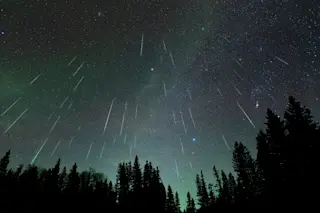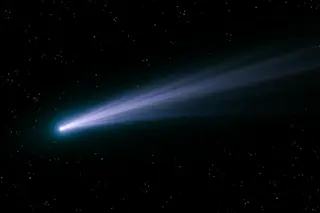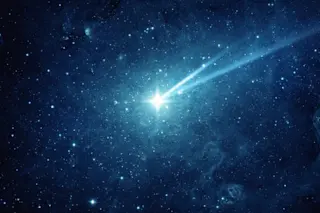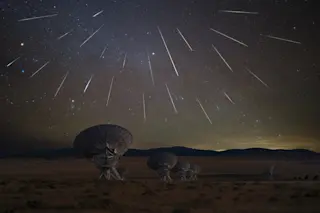For sky watchers the event of the year was clearly the arrival of comet Hale-Bopp, which burned bright in northwestern skies from late March through May. The biggest and brightest comet since the Great Comet of 1811, it was visible even through murky city air. The first sightings, in July 1995, had been made by two experienced observers, Alan Hale and Thomas Bopp, and two years later their peers came out in force. Astronomy clubs planned Hale-Bopp parties; amateur photographers flooded the Internet with snapshots and viewing tips. And on another plane entirely, members of a fanatical New Age cult committed mass suicide, hoping to ride the comet to a higher form of existence.
In the ensuing uproar the astronomy seemed almost secondary. But Hale-Bopp was also of great scientific interest: it was the first comet with three tails ever seen. Even lazy observers could easily spot the bright but squat dust tail, and a little more effort revealed the narrower tail of ionized gas. The first reports of the third tail came on April 18 from a team of European astronomers at the Isaac Newton Group of Telescopes on the Canary Islands. Their images of the comet revealed a thin, faint, jetlike tail some 30 million miles long and nearly 400,000 miles wide, pointing in a direction almost exactly opposite the sun—and made entirely of sodium atoms. By May, other astronomers had processed their own images of the comet, and they saw a sodium tail too—although not necessarily of the same shape and size. In our data it is wide—roughly the same size as the dust tail—and it gets wider as it moves away from the comet, and it’s also slightly curved, says astronomer Jody Wilson of Boston University.
The European team has suggested that the tail is produced by sodium gas escaping directly from the nucleus, Wilson goes on. But that is how you get a narrow tail. He and his colleagues have another theory to explain the wide sodium tail: the sodium atoms are coming off the grains in the comet’s wide-fanning dust tail. But whereas the dust is pulled by the sun’s gravity into a curving wake behind the comet nucleus, the lighter sodium atoms are influenced more strongly by the pressure of solar radiation and are pushed away from the sun. Thus they separate from the dust and form a distinct third tail—or at least it was distinct if you had a large telescope.
Astronomers don’t expect to find hidden sodium tails in all the comets that cross our skies. Last year’s comet Hyakutake, for one, was noticeably lacking in sodium. You would expect more sodium to come from comets that have more dust, Wilson says. That is consistent with Hyakutake. It was almost all ices that turned into gas, and we saw very little sodium.














